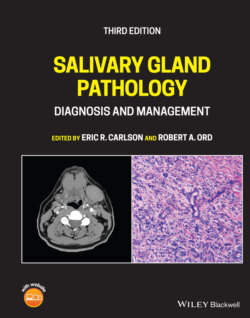Читать книгу Salivary Gland Pathology - Группа авторов - Страница 125
ACUTE BACTERIAL SUBMANDIBULAR SIALADENITIS
ОглавлениеAcute bacterial submandibular sialadenitis (ABSS) is usually associated with physical obstruction of the Wharton duct and therefore presents as swelling associated with the submandibular gland. That said, physical examination of the patient with submandibular swelling may not immediately disclose whether the swelling is related to sialadenitis of the submandibular gland, to neoplastic disease of the submandibular gland, or due to a process extrinsic to the submandibular gland. As such, CT scans become required when the distinction cannot be made entirely on physical findings alone (Figure 3.13a). This notwithstanding, sialolithiasis, the likely cause of obstruction of the duct with resultant submandibular gland swelling, is discussed in Chapter 5, it is only briefly mentioned here. Suffice it to say that the submandibular ductal system is prone to stone formation. The common features of ABSS are swelling in the submandibular region associated with prandial pain. ABSS is a community acquired disease that less frequently is associated with dehydration and hospitalization as compared to ABP. Purulence may be expressed from the opening of the Wharton duct, but in many cases, complete obstruction to pus and saliva occurs. As in the case of acute bacterial parotitis, imaging studies are also obtained in patients with clinically unequivocal acute bacterial submandibular sialadenitis when signs and symptoms are of a magnitude to justify acquiring CT scans (Figure 3.13b).
Figure 3.13. The CT scan (a) of a 73‐year‐old man with a one‐year history of right submandibular swelling. Physical examination of the neck identified a mass with a differential diagnosis of submandibular gland mass vs. enlarged lymph node in the submandibular region. This CT scan was obtained due to the equivocal nature of the finding on physical examination. Fine needle aspiration biopsy of this mass led to a diagnosis of low‐grade lymphoma. By distinction, a 24‐year‐old woman with right submandibular swelling and pain who underwent a CT scan that identified intense uptake of intravenous contrast of the right submandibular gland indicative of acute bacterial submandibular sialadenitis (b). Fat stranding in the left neck indicative of inflammation is also noted.
Figure 3.14. Algorithm for diagnosis and management of acute bacterial submandibular sialadenitis (ABSS).
